
Mainframe Modernization Market
Mainframe Modernization Market by Software (Application Modernization, Mainframe Optimization), Modernization Services (Application Modernization, Optimization, Operations, Mainframe-as-a-Service), Vertical, Region - Global Forecast to 2030




OVERVIEW
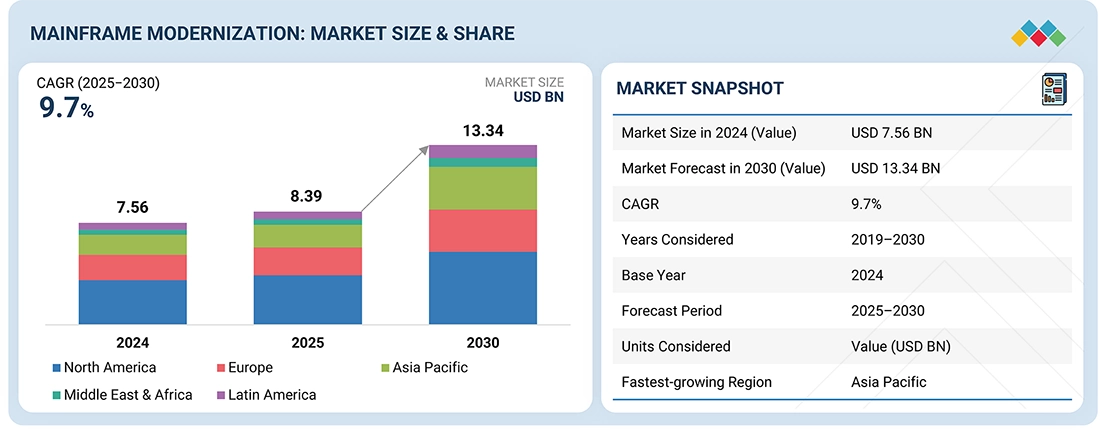
Source: Secondary Research, Interviews with Experts, MarketsandMarkets Analysis
The mainframe modernization market is expected to grow from USD 8.39 billion in 2025 to USD 13.34 billion by 2030, with a CAGR of 9.7% during the forecast period. Mainframe modernization is now crucial for enterprises aiming to transform legacy systems into agile, secure, and intelligent platforms that meet shifting digital demands. Workforce retirements, stricter regulations, and data growth are pushing organizations in banking, telecom, insurance, and government sectors to accelerate modernization efforts. Leading providers like IBM and AWS utilize AI-powered tools such as watsonx Code Assistant and AWS Transform to automate complex code refactoring and minimize risks. Strategic partnerships, such as IBM with Finanz Informatik and Capgemini’s AI-driven modernization for insurers, showcase innovation that boosts security and compliance. While Asia Pacific speeds up adoption through cloud integration and regulation, North America leads with large-scale, compliance-focused projects like JPMorgan Chase’s modernization initiatives. This evolving market combines AI, cloud-native architectures, and modular services to deliver resilience, innovation, and long-term value from legacy IT environments.
KEY TAKEAWAYS
-
BY OFFERINGModernization services will account for the largest market size, driven by rising demand for re-platforming, re-hosting, and application transformation.
-
BY ORGANIZATION SIZELarge enterprises will hold the dominant share, as they manage complex legacy workloads and require scalable modernization.
-
BY VERTICALThe BFSI sector will contribute the largest share, owing to regulatory compliance needs and core banking system transformation.
-
BY REGIONNorth America leads in terms of market share due to early adoption and mature vendor ecosystems, while Asia Pacific will grow fastest with rapid digitalization and government-led initiatives.
-
COMPANY LANDSCAPEThe major market players have adopted both organic and inorganic strategies including partnerships and investments. For instance, IBM partnered with AWS to accelerate mainframe application modernization, enabling enterprises to migrate and run legacy workloads on the cloud with greater agility.
The mainframe modernization market is experiencing strong growth, with modernization services becoming the largest segment, driven by enterprises pursuing re-platforming, re-hosting, and application transformation. Large enterprises dominate the market as they handle complex legacy workloads that require scalable modernization solutions, while the BFSI sector leads vertical adoption due to regulatory compliance and core banking system changes. Regionally, North America holds the largest share, supported by early adoption and well-established vendor ecosystems, whereas Asia Pacific is expected to grow the fastest thanks to rapid digitalization and government-led initiatives. In the competitive landscape, collaborations such as IBM’s partnership with AWS are speeding up modernization efforts, allowing enterprises to migrate legacy applications to cloud environments with greater agility and cost savings.
TRENDS & DISRUPTIONS IMPACTING CUSTOMERS' CUSTOMERS
The mainframe modernization market is being driven by the need for enterprises to transform legacy systems and align with rapidly changing business priorities. Organizations across BFSI, IT & ITeS, and manufacturing are moving from traditional revenue models to modernization-led opportunities, with a strong focus on regulatory compliance, customer experience, cloud enablement, and supply chain optimization. These initiatives are helping clients reduce operational risks, lower infrastructure costs, accelerate time-to-market, and enhance decision-making, thereby creating scalable digital services and improved business outcomes for their end customers.
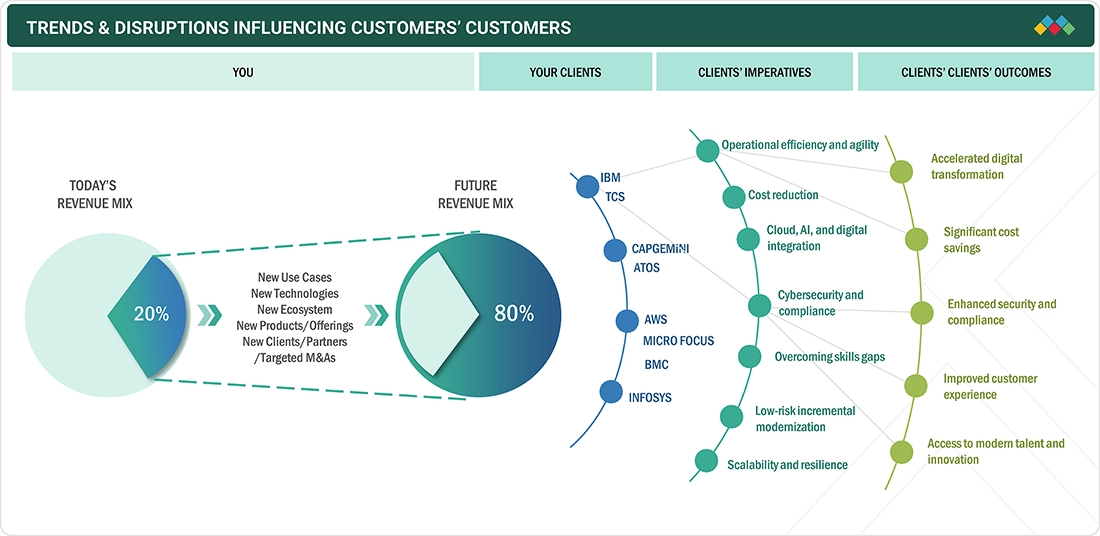
Source: Secondary Research, Interviews with Experts, MarketsandMarkets Analysis
MARKET DYNAMICS
Level
-
Need for agility, speed, and digital transformation

-
Cost reduction and operational efficiency
Level
-
High complexity of legacy applications
-
Risk of business disruption during transformation
Level
-
Accelerated innovation with cloud-native and AI tools
-
Migration to pay-as-you-go and managed modernization services
Level
-
Understanding legacy system architecture and code complexity
-
Ensuring data integrity and compliance during migration
Source: Secondary Research, Interviews with Experts, MarketsandMarkets Analysis
Driver: Need for agility, speed, and digital transformation
A key factor driving mainframe modernization is the rapid retirement of experienced professionals, which creates a critical skills gap and elevates operational risks. Many organizations in banking, insurance, and government have depended on the “institutional knowledge” of senior developers for decades; as these experts near retirement age, over 60% are now above 50, and much of the essential knowledge to maintain and modify mainframe applications leaves with them. This makes modernization not just advantageous but essential, since new hires often lack deep expertise in COBOL, JCL, or assembler. For instance, Legal & General, a leading UK financial services firm, prioritized retaining and transferring developer and tester knowledge before initiating their mainframe overhaul, supporting their workforce with new tools and gradual modernization rather than sudden changes. Companies like IBM are tackling this issue by incorporating AI and automation into their modernization tools to close the skills gap, while Ensono has highlighted the rise in mainframe retirements and the increasing costs and challenges of recruiting or training new mainframe talent.
Restraint: High complexity of legacy applications
One of the biggest challenges in mainframe modernization is the complex task of migrating legacy codebases, which often consist of millions of lines of undocumented code and tightly coupled business logic. Legacy applications, developed over decades using COBOL, PL/I, or assembler, usually lack up-to-date documentation, making it hard to understand dependencies and avoid breaking essential processes. This often turns many mainframe environments into “black boxes,” hindering innovation and creating resistance to changes. For example, organizations like European banks face multi-year timelines for modernization because their applications support core payment and compliance systems that cannot afford downtime. To address this, companies like Royal Cyber and Micro Focus use static code analysis tools and smart parsers to map dependencies and find reusable code segments before starting any transformation. Nonetheless, the risk of data loss and business disruption remains high unless the migration is carefully planned and executed, leading organizations to adopt hybrid or phased modernization strategies supported by both automation and expert guidance.
Opportunity: Accelerated innovation with cloud-native and AI tools
A major opportunity in mainframe modernization is the swift growth of adoption among small and mid-sized businesses (SMEs), driven by modular, consumption-based, and cloud-native modernization solutions. Traditionally, SMEs faced challenges with high costs, limited resources, and risks tied to mainframe upgrades. However, companies like AWS and Astadia now provide AI-driven code refactoring and “starter” modernization packages, allowing SMEs to upgrade specific applications gradually, often beginning with less critical workloads. Additionally, the increased availability of automation and managed migration services enables smaller firms to overcome the industry-wide legacy skills shortage, opening new opportunities for digital agility and competitiveness.
Challenge: Ensuring data integrity and compliance during migration
Ensuring continuous business operations during mainframe modernization remains a key challenge, especially for organizations with 24/7 operational needs like those in banking, utilities, and government. Even short outages can lead to significant financial losses, reputational damage, and regulatory fines. Legal & General addressed this by actively involving their developers and ensuring strong support during the upgrade, keeping policyholder services stable for their 5.5 million pension customers throughout the process. Technology companies such as CGI and IBM emphasize the importance of phased rollouts, dual-run (blue/green) deployments, and automated testing to reduce risks during migration. Other effective practices include thorough regression testing, sandbox environments, and monitoring tools for real-time anomaly detection, all helping companies modernize critical workloads while maintaining normal operations. By focusing on business continuity with these techniques, organizations can innovate without sacrificing reliability or regulatory compliance.
Mainframe Modernization Market: COMMERCIAL USE CASES ACROSS INDUSTRIES
| COMPANY | USE CASE DESCRIPTION | BENEFITS |
|---|---|---|
 |
Modernizes COBOL/PL1-based systems into hybrid cloud; integrates AI & automation for BFSI and government sectors; provides z/OS Cloud Broker for Kubernetes deployments. | Improved system resilience, faster compliance readiness, optimized TCO (total cost of ownership) |
 |
Enables migration of mainframe workloads to AWS cloud using tools like AWS Mainframe Modernization, refactoring legacy apps into Java/Spring; strong partner ecosystem. | Reduced infrastructure cost, on-demand scalability, accelerated innovation cycles |
 |
Offers “MasterCraft” modernization suite; automates code conversion, re-platforming, and microservices transition for BFSI, manufacturing, and telecom. | Faster transformation timelines, minimized risk in migration, seamless integration with digital platforms |
 |
Provides end-to-end legacy renewal through its “Perform AI” and application re-platforming frameworks; strong in retail and BFSI clients shifting to cloud-native apps. | Enhanced agility, better user experience, optimized operations through automation |
 |
Uses proprietary tools like “Automated Source Code Transformation” and “Z Cloud” solutions; supports hybrid modernization for ITES and manufacturing clients. | Lower modernization costs, flexible hybrid IT deployment, improved business continuity |
Logos and trademarks shown above are the property of their respective owners. Their use here is for informational and illustrative purposes only.
MARKET ECOSYSTEM
The mainframe modernization landscape includes a diverse ecosystem of companies, each playing distinct but often overlapping roles as service providers, software vendors, or hybrid organizations offering both. These companies range from global IT consultancies and cloud hyperscalers that deliver comprehensive modernization services to specialized software firms developing automation and migration tools, as well as emerging players that seamlessly combine proprietary platforms with tailored consulting expertise. Categorizing these market participants by their core offerings helps enterprises identify the best mix of partners, understand their value propositions, and develop effective modernization strategies aligned with both technology and business goals. This structured approach ultimately highlights the collaborative and multi-layered nature of the mainframe modernization market.
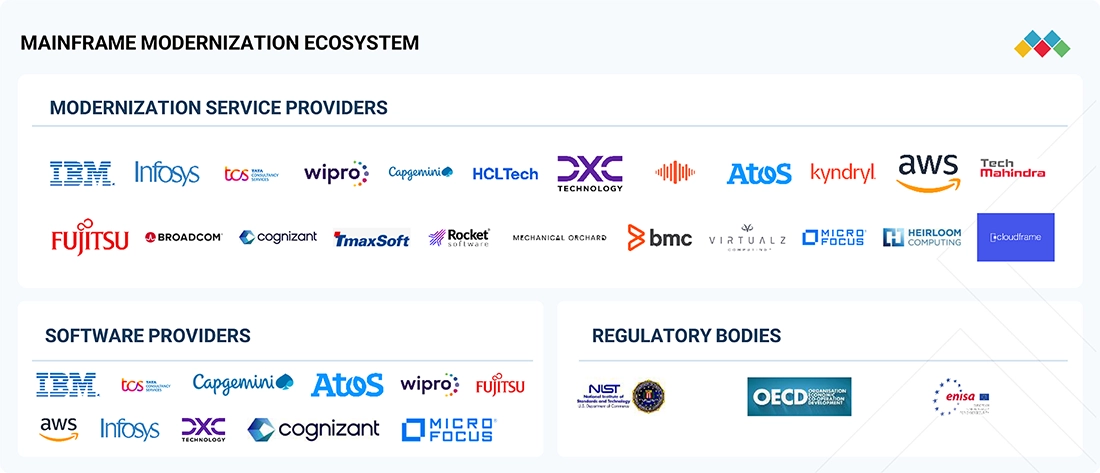
Logos and trademarks shown above are the property of their respective owners. Their use here is for informational and illustrative purposes only.
MARKET SEGMENTS
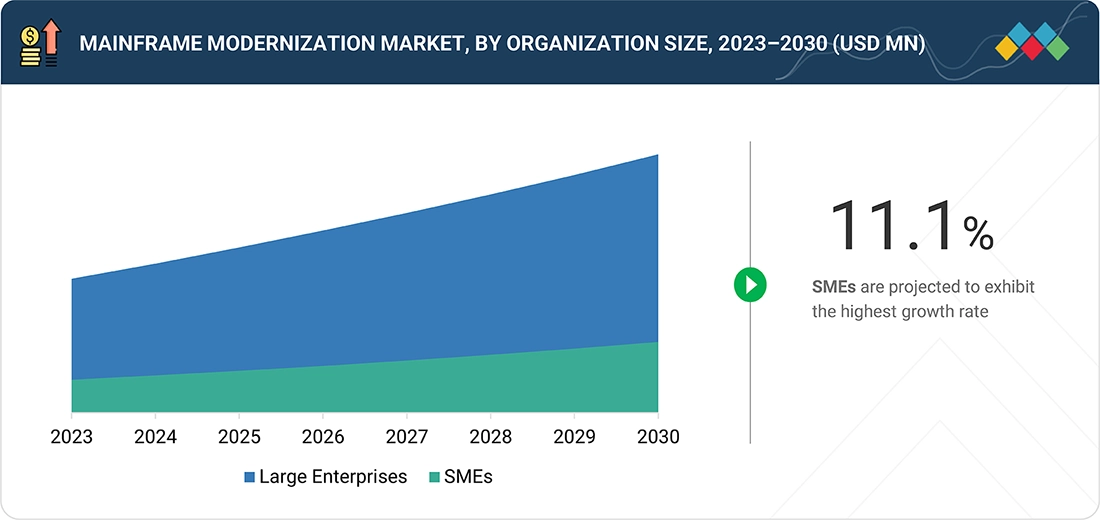
Source: Secondary Research, Interviews with Experts, MarketsandMarkets Analysis
MAINFRAME MODERNIZATION MARKET, BY ORGANIZATION SIZE
The mainframe modernization market by organization size is currently dominated by large enterprises, as they rely heavily on complex legacy systems to support core business operations, manage high transaction volumes, and meet regulatory requirements. Their greater IT budgets and resources allow for large-scale modernization initiatives, making their overall market size significantly higher than SMEs. However, SMEs are expected to grow at the fastest rate (11.1%) during 2023–2030, as they increasingly adopt cloud-native and cost-efficient modernization approaches to enhance agility, scalability, and competitiveness.
REGION
Asia Pacific to be fastest-growing region in global Mainframe Modernization market during forecast period
Asia Pacific is rapidly emerging as the fastest-growing market for mainframe modernization, driven by swift digital transformation across industries such as BFSI, telecom, and manufacturing, where companies are transitioning from legacy systems to cloud-native platforms. Government-led digital initiatives, regulatory compliance demands, and the push for resilient IT infrastructure are prompting organizations to modernize core applications on a large scale. The region’s increasing cloud adoption, growing demand for automation, and rising investments by global providers are further propelling this trend, establishing Asia Pacific as the most vibrant growth hub in the mainframe modernization sector.
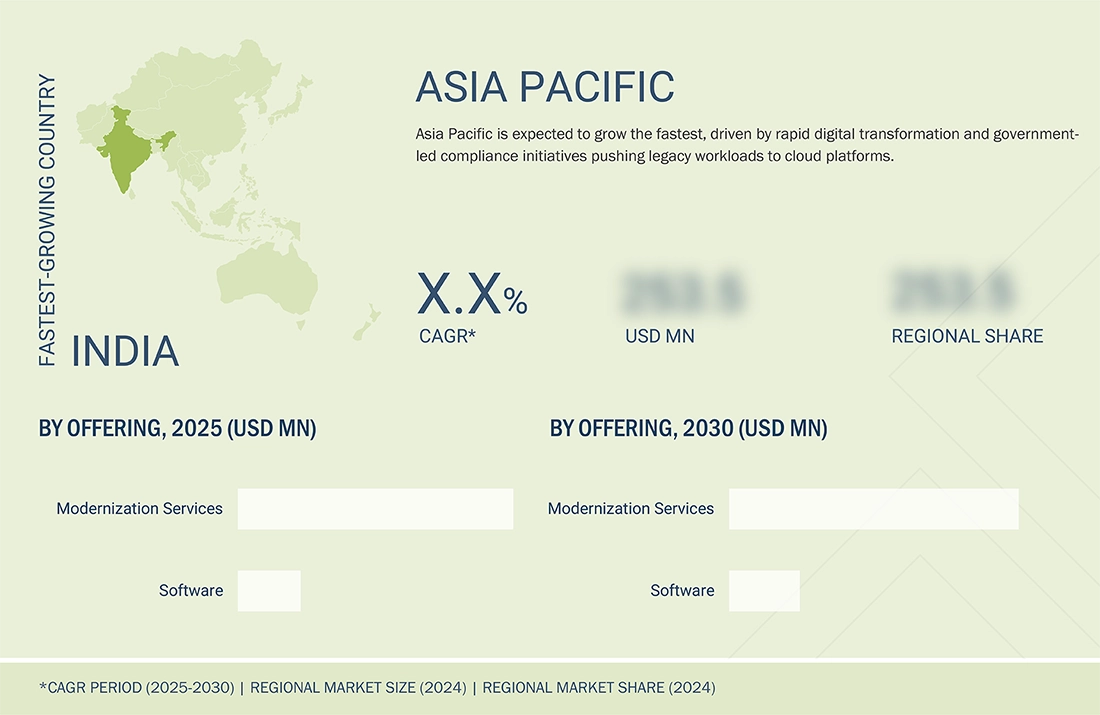
Mainframe Modernization Market: COMPANY EVALUATION MATRIX
The company evaluation matrix for the mainframe modernization market positions vendors based on their market share and product capabilities. Leading players such as TCS, IBM, AWS, HCLTech, and Capgemini are categorized as “Stars,” reflecting strong portfolios, execution capabilities, and significant market presence. DXC Technology is placed among the “Emerging Leaders,” showing potential for growth with focused offerings. Companies like Infosys, Accenture, Cognizant, and Wipro fall into the “Pervasive Players” quadrant, indicating widespread adoption but relatively moderate differentiation. Meanwhile, players such as Broadcom, TmaxSoft, BMC, Fujitsu, and Tech Mahindra are clustered with narrower market reach, signaling specialized but limited influence in the modernization ecosystem.
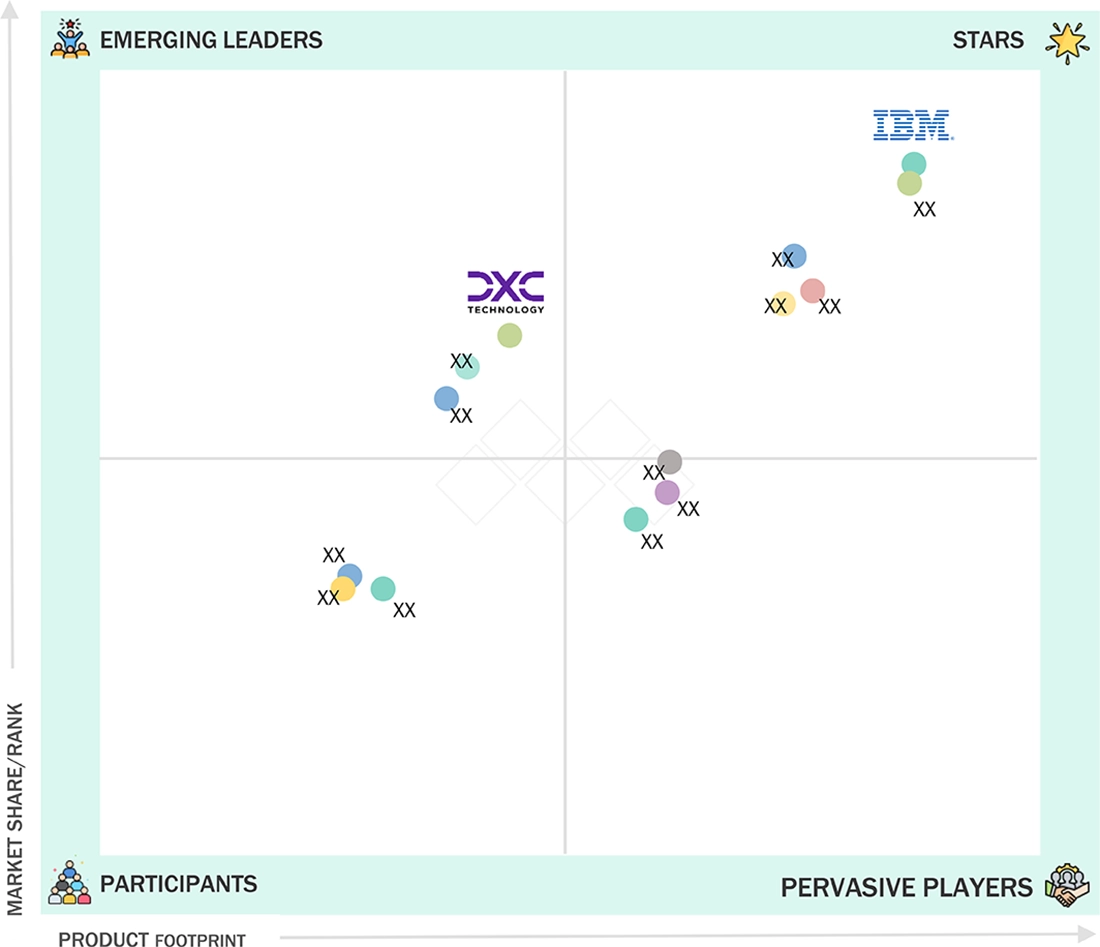
Source: Secondary Research, Interviews with Experts, MarketsandMarkets Analysis
KEY MARKET PLAYERS
MARKET SCOPE
| REPORT METRIC | DETAILS |
|---|---|
| Market Size Value in 2024 | USD 8.39 Billion |
| Revenue Forecast in 2030 | USD 13.34 Billion |
| Growth Rate | CAGR of 9.7% from 2025-2030 |
| Years Considered | 2019–2030 |
| Base Year | 2024 |
| Forecast Period | 2025–2030 |
| Units Considered | Value (USD Milion/Billion) |
| Report Coverage | Revenue forecast, company ranking, competitive landscape, growth factors, and trends |
| Segments Covered |
|
| Regions Covered | North America, Europe, Asia Pacific, Middle East & Africa, and Latin America |
WHAT IS IN IT FOR YOU: Mainframe Modernization Market REPORT CONTENT GUIDE
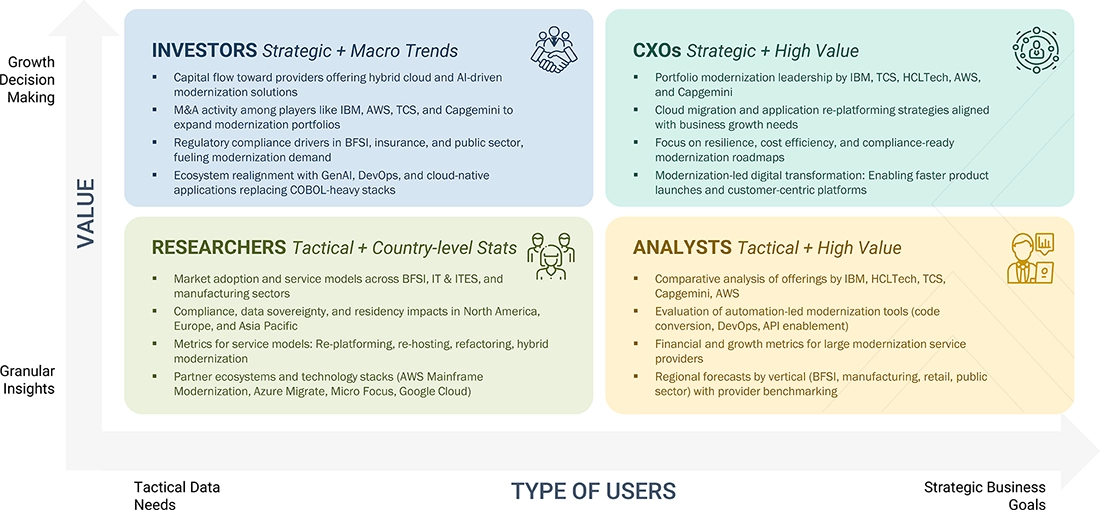
DELIVERED CUSTOMIZATIONS
We have successfully delivered the following deep-dive customizations:
| CLIENT REQUEST | CUSTOMIZATION DELIVERED | VALUE ADDS |
|---|---|---|
| Leading Provider (US) |
|
|
| Company Information | Detailed analysis and profiling of additional market players (up to 5) |
|
RECENT DEVELOPMENTS
- July 2025 : IBM officially released IBM z/OS 3.2 to unlock the potential of its new IBM z17 mainframe, supporting hybrid cloud environments and advanced AI acceleration. This update enables clients to run both traditional and generative AI models directly on sensitive mainframe data in real time, boosting insights and making compliance easier for global enterprises.
- June 2025 : ASISA, a leading Spanish insurer, partnered with HCLTech to drive comprehensive mainframe modernization. Through this alliance, HCLTech will deliver a new digital foundation by modernizing ASISA’s core legacy systems, enabling greater agility and business responsiveness across Iberia and reinforcing their leadership in the insurance sector.
- May 2025 : AWS announced the broad availability of AWS Transform for Mainframe, an AI-powered service that significantly accelerates modernization by automating code analysis, refactoring, migration planning, and documentation. The platform allows partners and large organizations, such as Transamerica, Allianz, and Marriott, to migrate their core IBM z/OS workloads to the cloud in a timeframe measured in months instead of years.
- May 2025 : Capgemini introduced a next-generation mainframe modernization platform powered by generative and agentic AI. This new solution automates converting outdated COBOL applications into flexible, cloud-native architectures and has already assisted a major US insurer in quickly migrating their policy administration system with greater accuracy than traditional methods, reducing errors and shortening implementation times.
Table of Contents

Methodology
The research study involved four major activities in estimating the mainframe modernization market size. Secondary research was done to collect important information about the market and peer markets. The next step was to validate these findings and assumptions and size them with the help of primary research with industry experts across the value chain. Both top-down and bottom-up approaches were used to estimate the market size. The market breakdown and data triangulation were adopted to estimate the market sizes of segments and sub-segments.
Secondary Research
The market size of the companies offering mainframe modernization solutions to various end users was determined based on the secondary data available through paid and unpaid sources, analyzing the product portfolios of major companies in the ecosystem, and rating the companies based on their performance and quality. In the secondary research process, various sources were referred to identify and collect information for the study. The secondary sources include annual reports, press releases, investor presentations of companies, white papers, certified publications, and articles from recognized associations and government publishing sources.
Secondary research was mainly used to obtain critical information about industry insights, the market’s monetary chain, the overall pool of key players, market classification and segmentation according to industry trends to the bottom-most level, regional markets, and key developments from market-oriented and technology-oriented perspectives.
Primary Research
In the primary research process, various sources from the supply and demand sides were interviewed to obtain qualitative and quantitative information for the report, such as Chief Experience Officers (CXOs), Vice Presidents (VPs), directors from business development, marketing, and product development/innovation teams, and related key executives from mainframe modernization solutions vendors, system integrators, professional and managed service providers, industry associations, independent consultants, and key opinion leaders.
Primary interviews were conducted to gather insights, such as market statistics, data on revenue collected from platforms and services, market breakups, market size estimations, market forecasts, and data triangulation. Stakeholders from the demand side, such as Chief Information Officers (CIOs), Chief Finance Officers (CFOs), Chief Strategy Officers (CSOs), and the installation team of end users who use mainframe modernization solutions, were interviewed to understand buyers’ perspectives on suppliers, products, service providers, and their current use of mainframe modernization solutions which is expected to affect the overall mainframe modernization market growth.
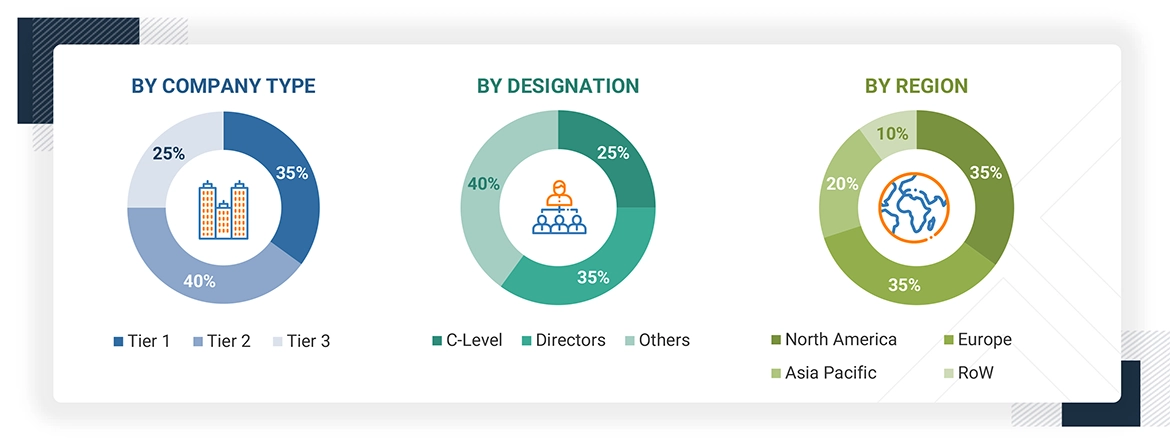
Notes: Tier 1 companies have revenues over USD 1 billion, Tier 2 companies range between USD 500 million
and 1 billion in overall revenues, and Tier 3 companies have revenues less than USD 500 million.
Other designations include sales managers, marketing managers, and product managers.
Source: Industry Experts
To know about the assumptions considered for the study, download the pdf brochure
Market Size Estimation
The top-down and bottom-up approaches were used to estimate and validate the total size of the mainframe modernization market. These methods were also used extensively to estimate the size of various subsegments in the market.
Mainframe Modernization Market : Top-Down and Bottom-Up Approach
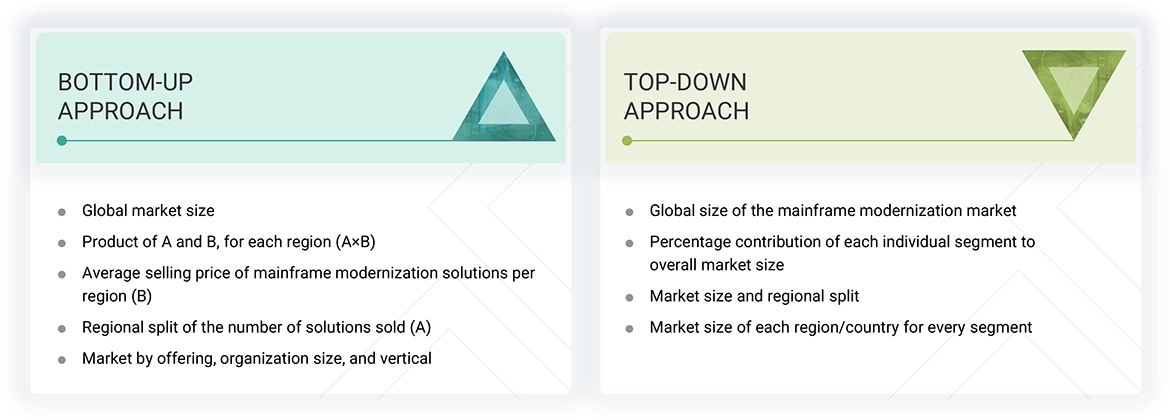
Data Triangulation
After determining the overall market size from the above estimation process, the mainframe modernization market was split into several segments and sub-segments. Data triangulation and market breakdown procedures were used, wherever applicable, to complete the overall market engineering process and arrive at the exact statistics for all segments and sub-segments. The data was triangulated by studying various factors and trends from the demand and supply sides. The mainframe modernization market size was validated using top-down and bottom-up approaches.
Market Definition
According to Cognizant, mainframe modernization is the process of migrating or improving an enterprise’s existing legacy mainframe footprint in the areas of interface, code, cost, performance and maintainability. In some instances, mainframe modernization can encompass the complete migration of code and functionality to a platform that is based on newer technology and/or hosted in the cloud.
Stakeholders
- Technology and Software Providers
- Consulting and Systems Integrators
- Cloud Platform Providers
- IT Outsourcing and Managed Service Providers
- End-user Enterprises and Industry Sectors
- Regulators and Compliance Authorities
- Application Testing, QA, and Security Vendors
- Training and Talent Development Organizations
- Industry Associations and Standards Bodies
- Corporate and Business Leadership
Report Objectives
- To determine, segment, and forecast the mainframe modernization market based on offering, organization size, verticals, end user, and region in terms of value
- To forecast the size of the market segments with respect to five main regions: North America, Europe, Asia Pacific, Middle East & Africa, and Latin America
- To provide detailed information about the major factors (drivers, restraints, opportunities, and challenges) influencing the market growth
- To study the complete value chain and related industry segments, and perform a value chain analysis of the market landscape
- To strategically analyze the macro and micromarkets1 with respect to individual growth trends, prospects, and contributions to the total market
- To analyze the industry trends, pricing data, patents, and innovations related to the market
- To analyze the opportunities for stakeholders by identifying the high-growth segments of the market
- To profile the key players in the market and comprehensively analyze their market share/ranking and core competencies2
- To track and analyze competitive developments, such as mergers & acquisitions, product launches & developments, partnerships, agreements, collaborations, business expansions, and research & development (R&D) activities
Available Customizations
With the given market data, MarketsandMarkets offers customizations per the company’s specific needs. The following customization options are available for the report:
Geographic Analysis as per Feasibility
- Further break-up of the Asia Pacific market into countries contributing 75% to the regional market size
- Further break-up of the North American market into countries contributing 75% to the regional market size
- Further break-up of the Latin American market into countries contributing 75% to the regional market size
- Further break-up of the Middle East African market into countries contributing 75% to the regional market size
- Further break-up of the European market into countries contributing 75% to the regional market size
Company Information
- Detailed analysis and profiling of additional market players (up to five)
Key Questions Addressed by the Report
What is the definition of mainframe modernization?
Mainframe modernization, according to Cognizant, involves migrating or enhancing an enterprise’s existing legacy mainframe systems in terms of interface, code, cost, performance, and maintainability. In some instances, mainframe modernization can encompass the complete migration of code and functionality to a platform that is based on newer technology and/or hosted in the cloud.
What is the size of the mainframe modernization market?
The mainframe modernization market is projected to grow from USD 8.39 billion in 2025 to USD 13.34 billion by 2030, at a CAGR of 9.7%, during the forecast period.
What are the major drivers of the mainframe modernization market?
Major drivers of the mainframe modernization market include cloud adoption, need for digital transformation, high legacy system maintenance costs, demand for business agility, integration with ai and analytics, regulatory and compliance pressures, global expansion of digital banking and fintech, rise in hybrid and multi-cloud environments, shortage of skilled mainframe professionals, need for faster time-to-market, and increasing focus on cybersecurity and data privacy.
Who are the key players operating in the mainframe modernization market?
The major players in the mainframe modernization market include IBM (US), TCS (India), Capgemini (France), Atos (France), AWS (US), Micro Focus (UK), BMC Software (US), Infosys (India), Wipro (India), HCL Tech (India), DXC Technology (US), Kyndryl (US), Rocket Software (US), Fujitsu (Japan), Cognizant (US), Tech Mahindra (India), Broadcom (US), TmaxSoft (US), PalmDigitalz (India), TSRI (US), Mechanical Orchard (US), Virtualz Computing (US), CloudFrame (US), and Heirloom (US). These players have adopted various growth strategies, such as partnerships, agreements, collaborations, product launches/enhancements, and acquisitions, to expand their footprint in the mainframe modernization market.
What are the opportunities for new entrants in the mainframe modernization market?
Globally, the mainframe modernization market offers significant opportunities as enterprises across sectors aim to reduce technical debt and align legacy systems with modern IT architectures. The push for cloud migration, coupled with the rise of AI, machine learning, and real-time analytics, is creating demand for flexible, scalable modernization solutions. Moreover, emerging markets are beginning to modernize aging infrastructure, opening new avenues for vendors and service providers.
Need a Tailored Report?
Customize this report to your needs
Get 10% FREE Customization
Customize This ReportPersonalize This Research
- Triangulate with your Own Data
- Get Data as per your Format and Definition
- Gain a Deeper Dive on a Specific Application, Geography, Customer or Competitor
- Any level of Personalization
Let Us Help You
- What are the Known and Unknown Adjacencies Impacting the Mainframe Modernization Market
- What will your New Revenue Sources be?
- Who will be your Top Customer; what will make them switch?
- Defend your Market Share or Win Competitors
- Get a Scorecard for Target Partners
Custom Market Research Services
We Will Customise The Research For You, In Case The Report Listed Above Does Not Meet With Your Requirements
Get 10% Free Customisation












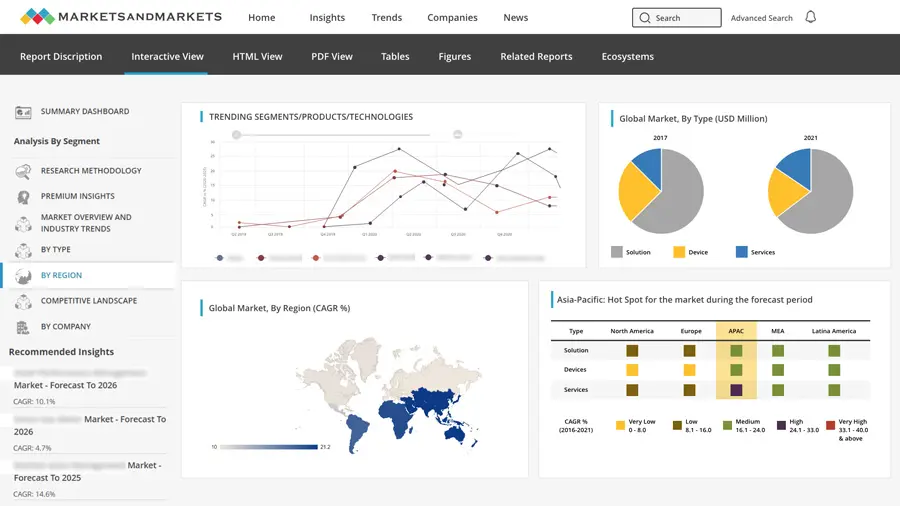
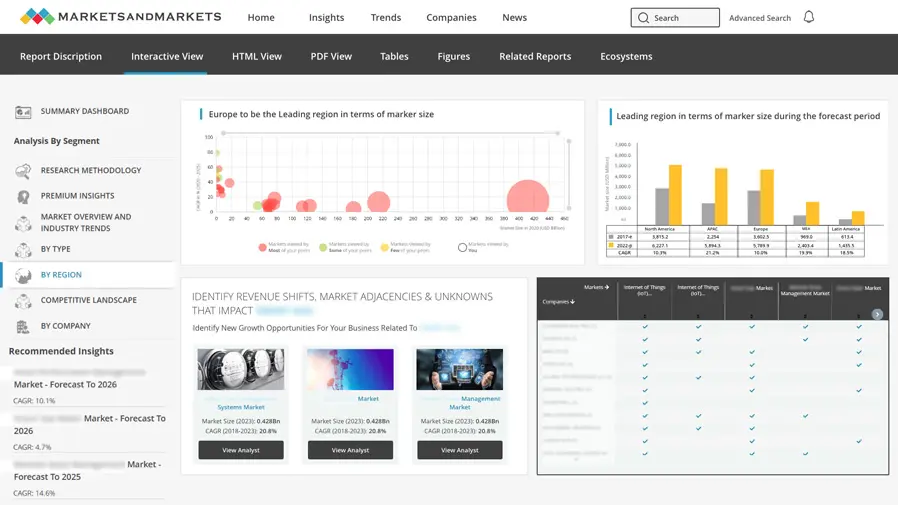
Growth opportunities and latent adjacency in Mainframe Modernization Market